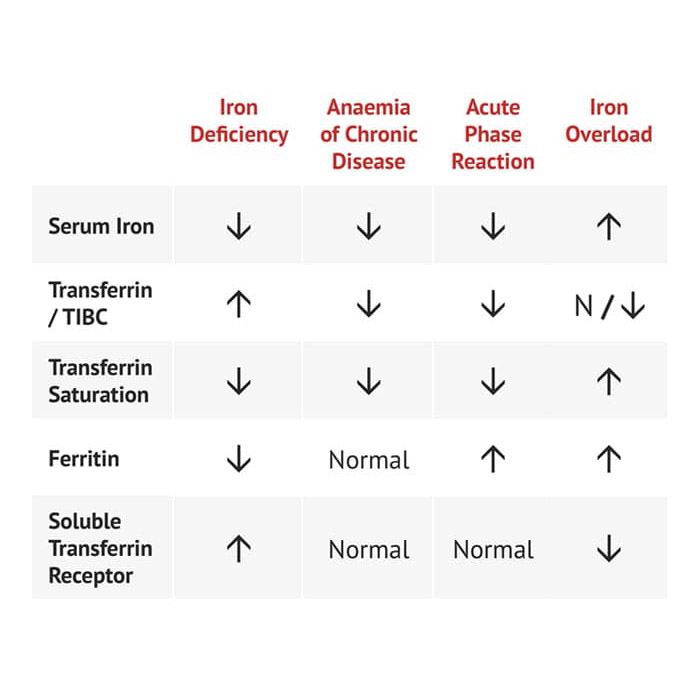

Individual chemical pathologists may be contacted but will not be available at all times.

If email is not a suitable option, please contact the on-call chemical pathologist via If the query concerns a specific patient please include the NHI number in your email.

This may be due to haemochromatosis, or one of several secondary causes of iron overload. Iron Overload This refers to an excess of total body iron stores. If a soluble transferrin receptor is ordered, this is usually increased. The pharmacokinetics and pharmacodynamics of iron preparationsĮmails receive priority attention from the on-call chemical pathologist. Iron studies reveal a reduced ferritin level and reduced transferrin saturation. Not be recommended to repeat iron studies for at least 10 days The half-life of ferric carboxymaltose is about 12hrs, however given the large iron load with a single dose it would

Iron infusion (such as ferric carboxymaltose) Screening with iron studies and genetic testing should be offered to all. ARUP Consult assists with test selection and interpretation. Therefore, care must be taken when interpreting TSAT results if concomitant. The table shows typical findings in disease states.īecause of diurnal variation, a morning (0800 h - 0900 h) specimen is preferred Aid in the diagnosis of iron deficiency anemia and iron overload. TIBC test (total iron-binding capacity) measures all proteins needed to link iron including transferrin (means the total transferring available). Ferritin test measures how much iron is stored inside cells. However ferritin is increased nonspecifically in many inflammatory disorders the ferritin concentration may be normal, or increased, even though the patient is iron deficient. A quick summary of iron blood test: Serum iron blood test measures how much iron inside the body. Decreased in iron overload, inflammation & infection, and liver disease.ĭifferentiating iron-deficiency anaemia from that of chronic disease can be difficult. : iron deficiency anaemia, anaemia associated with chronic disorders. : iron poisoning, haemochromatosis, anaemias which are not due to iron deficiency especially when treated with transfusions, and liver disease. Concentrations may also vary widely from day to day in the same patient. Low serum iron cannot be interpreted in isolation because it might be seen in. But which of these tests are most useful Both the presence of storage iron and the. If your results are abnormal, additional tests will determine whether iron is being stored in your liver, not being transported to the right places in your body, or what type of anemia you have.0.5 mL Paediatric Micro-PST Blood (Preferred)Ĭoncentrations are generally higher in the morning, but the diurnal variation is inconsistent. Important points to consider when interpreting iron studies in the context of iron deficiency - Suspected iron deficiency anaemia is best investigated using serum ferritin. Iron status can be assessed by a wide range of tests, blood tests and more invasive procedures. Suggestions for the most helpful test in the conditions described is in bold. Child-bearing women have the highest requirements for iron because of the monthly loss of blood in their menstrual cycles. Interpretation of iron studies can be confusing with a number of the measures affected by iron therapy and acute phase response. If initial serum iron is low I repeat the test to identify if. Serum iron Considerable variation occurs within a day in individuals and assessment of serum iron alone provides little helpful clinical information. The following figures on Iron Studies are taken from Melbourne haematology guidelines. Measured in micrograms per deciliter (mcg/dl), normal ranges for serum iron differ depending on an individual’s age and sex. Iron studies require detailed interpretation. A serum iron test is ordered after abnormal results are found in a hemoglobin test or a complete blood count, or when you are showing symptoms of anemia. Interestingly, doctors working with patients who have hair loss have found that adequate iron levels may be tied to the ability to regrow hair.Ī serum iron test measures iron levels in the serum component of the blood. Measurement Interpretation: Normal Interpretation: Increased TIBC Interpretation: Decreased TIBC Extra: Related Bing Images Extra: Related Studies. About 65% of the iron in the body is found in the blood. Iron is found in different parts of the body – blood (called transferrin), muscle, liver (called ferritin) and enzymes in the body. Without iron, red blood cells cannot reproduce in the body. Iron is abbreviated Fe and an essential element required for hemoglobin production.


 0 kommentar(er)
0 kommentar(er)
